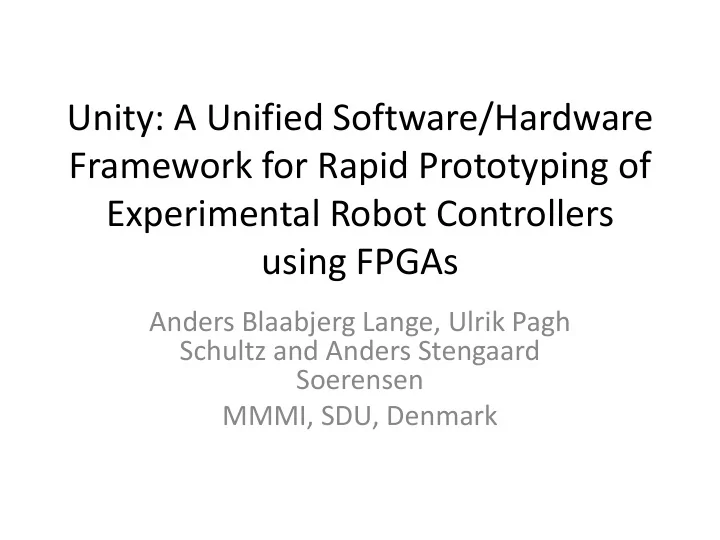

Unity: A Unified Software/Hardware Framework for Rapid Prototyping of Experimental Robot Controllers using FPGAs Anders Blaabjerg Lange, Ulrik Pagh Schultz and Anders Stengaard Soerensen MMMI, SDU, Denmark
OR why everyone in experimental robotics who cares about the real- world should use FPGA’s Anders Blaabjerg Lange, Ulrik Pagh Schultz and Anders Stengaard Soerensen MMMI, SDU, Denmark
Context: Experimental robotics @ SDU
Context: SDIR Q & A • Solved: overall high-level robotic frameworks • Best practice: components, middleware, MDSD • Robot-specific: low-level requirements that dominate high-level design • Remains to be solved: reusable and general low-level software • Inadequacy of state-of-the-art: high-level languages are not low-level, low-level languages lack reusability and abstraction • Promising research directions: MDSD and flexible electronics [modular, FPGA, ...]
Context: Why FPGAs? Pros Cons • Portable and reusable • Difficult to program components for hardware – different mindset interface and real-time – numerous low-level concerns control • History • Systems that are flexible • (Cost, power) and scalable Idea: generate low-level – single-node: true parallelism control of system from – multi-node: real-time network (TosNet, EPL) high-level specifications … and automatically integrate into high-level robot frameworks
UL-spec: SDIR-VIII demo link sdir8demo.sdir8; public demo(ctrl,uart) { TOSNET ( CTRL= ctrl , COMM= uart , BASE= 0); node2acc: acc("Node 2 acc") @ x=0x0081, @ y=0x0082) @ z=0x0083; node3acc: acc("Node 3 acc") @ x=0x00C9, @ y=0x00CA, @ z=0x00CB; @ led=0x0040: WRITE ( ID= "LED", CRC ); } acc(name): @ x, @ y, @ z { @ x: signed READ ( ID =name+": x", PUBLISH (1,1000), CRC ); @ y: signed READ ( ID =name+": y", PUBLISH (1,1000), CRC ); @ z: signed READ ( ID =name+": z", PUBLISH (1,1000), CRC ); }
Unity Link gateware architecture
Experiment: Latency
Experiment: Throughput
Work-in-progress: VHDL generation class led_blinker(Node): board = XC6LX45(ft232h=ftdi_uart_if) led = public(outputport(7)) ... def configure(self): self.board.ft232h = unity_serial(serial=self.board.ft232h,rate=mbaud(6)) self.board.leds = self.led .... 1. Architectural level: system generation from “template” 2. Component level: configuration, composition, generation
Technology comparison Single-node Distributed Application layers ROS Orocos, 4DIAC Execution layer LabView, PLC EPL, CAN Control layer Arduino Unity (TosNet) Electrical interface Transducer Physical/mechanical
Unity Link software stack [1/2]
Unity Link software stack [2/2]
UL-spec: SCARA case study public scara(ctrl,comm) { TOSNET ( CTRL =ctrl, COMM =comm, BASE =0); j1: joint("joint 1") @ (0x80,0x88,0x8C,0x94); j2: joint("joint 2") @ (0x81,0x89,0x8D,0x95); j3: joint("joint 3") @ (0x82,0x8A,0x8E,0x96); j4: joint("joint 4") @ (0x83,0x8B,0x8F,0x97); } joint(name): @ (spd,cpos,pos_sp,spd_sp) { @ cpos: signed READ ( ID =name+":cpos", PUBLISH (1,10)); @ spd: READ ( ID =name+":spd", PUBLISH (1,10)); @ pos_sp: signed WRITE ( ID =name+":pos_sp"); @ spd_sp: WRITE ( ID =name+":spd_SP"); }
Recommend
More recommend